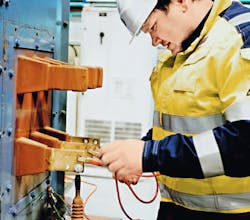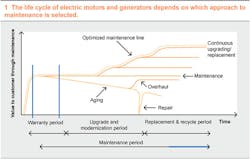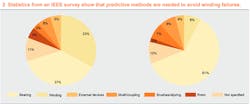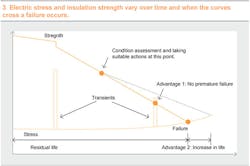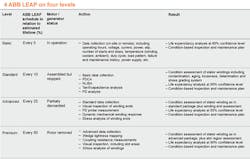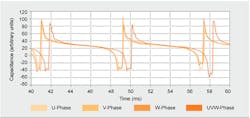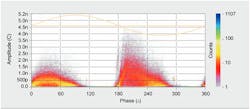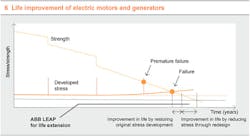A crucial factor to consider when planning maintenance of high-voltage (HV) motors and generators, especially those in critical industrial applications, is the life expectancy of the stator windings. HV motors and generators are typically custom-made so are not available offthe- shelf should an unexpected failure occur. This means that corrective maintenance is very time-consuming and the operator can experience extensive periods of costly, unforeseen downtime. How can such problems be predicted and avoided?
ABB LEAP for HV motors and generators can provide the answer. Based on a combination of different types of data, this service makes it possible to analyze the condition and expected life of a stator winding. This is an important part of a motor and generator lifecycle concept, in which maintenance plans are optimized for maximum user value ➔ 1. In other words, ABB LEAP enables optimized predictive maintenance, which delivers the best long term user benefits when compared with, say, a maintenance strategy based on corrective maintenance alone.
(left) 2a Detection during normal operation, (right) 2b Detection during maintenance or test
Large motor failures
Large motors and generators of 2 MW rating and up are designed for high power. They exhibit a relatively higher proportion of winding failures than lowerpower designs. Based on figures from an IEEE survey, 33 percent of all failures detected during normal operation are related to the stator winding ➔ 2. However, the corresponding figure for failures detected during maintenance or testing is only 8 percent. The figures for bearings were 37 and 61 percent, respectively. It can be concluded that the prediction of winding failures needs to be improved and that ABB LEAP can fill a critical gap in the maintenance toolbox of electric motors and generators.
ABB LEAP takes into account the aging of the stator winding insulation due to thermal, electric, mechanical and ambient factors to deliver a predicted life expectancy that has an 80 percent probability of being reached. As a result, maintenance plans can be optimized and necessary actions taken during planned downtime.
However, ABB LEAP is more than just an inspection package. It is also a tool for systematic maintenance management. In addition, the data itself is not the key element – how it is interpreted and analyzed is the important factor.
At the heart of this approach to motor and generator life-cycle management is the understanding of how electrical stress and insulation strength vary over time and their possible effects on the device materials.
Varying with time
The degradation of stator winding insulation can be described in general terms by using two curves to demonstrate how stress and strength change over time ➔ 3. The stress curve shows the combined loading on the winding insulation arising from its operation, including irregular conditions such as transients. The strength curve shows how operating conditions and aging influence the strength of the winding insulation. Failure occurs when these two curves cross.
ABB LEAP offers an electric motor or generator user the opportunity to preempt failure. Timely analysis allows prediction of the stator winding's residual life and maintenance can then be scheduled to avoid premature failure and costly unplanned downtime. Knowledge of the original residual life and the lifetime increase created by the maintenance measures ensure that the stress and strength curves will not meet unexpectedly.
Measurement methods
Scientifically predicting the residual life of a stator winding insulation involves a number of steps ➔ 4.
Before any analysis of a motor or generator's future prospects can be made, its present condition has to be determined. This demands knowledge of basic parameters such as operating hours, loading, number of starts, duty cycle, temperatures, maintenance history, etc. All of these factors have an impact on life expectancy and must be collected and included in the analysis.
However, not all data is available from specification sheets and motor or generator logs. A stator winding insulation, at different stages in the aging process, has properties that can only be explored through measurements. ABB LEAP includes four main measurement methods that provide information about the conditions on the surface and within the winding insulation:
- Polarization depolarization current analysis (PDCA)
- Tan δ and capacitance analysis
- Partial discharge (PD) analysis
- Nonlinear insulation behavior analysis (NLIBA)
5c Partial discharge activity collected over several voltage cycles
PDCA provides considerably more information than the more commonly used insulation resistance (IR) and polarization index (PI) measurements. PDCA is a DC method in which the winding insulation is initially charged and then discharged through a low-current meter to ground. Two curves are generated that describe the variation in current over time during these two steps of the measurement ➔ 5a. From these curves, it is possible to derive a charge storage value for winding insulation and compare it to reference values for normal conditions. This allows more comprehensive analysis than if only PI and IR were utilized and the method can deliver satisfactory values even with highly contaminated windings. PDCA gives an idea of the quantity and location of charge storage within the motor or generator insulation and identifies contamination on the winding surface. It also provides additional insights into the state of the winding insulation, including possible aging and looseness.
Tan δ and capacitance analysis is a standard method typically used before delivery of high-voltage electric motors and generators. Tan δ measurements provide an indication of the dielectric losses in the insulation. At a certain voltage, the associated curve exhibits a knee when partial discharges begin to occur in the winding ➔ 5b. A tan δ and capacitance analysis gives information about the extent of discharging air spaces in the insulation, condition of the resin, contamination, loose coils and other defects inside the stator insulation.
PD measurements are used to evaluate the extent and location of discharge activity in the stator insulation system. Partial discharges are filtered out by a coupling capacitor and terminating impedance and then recorded. Partial discharge activity is represented in one voltage cycle by the amplitude, phase and pulse count information collected over several voltage cycles ➔ 5c. The analysis considers the amplitude and shape of the partial discharge curve on the positive and negative phase of the voltage cycle for different voltage levels. This pattern gives information about where in the stator winding partial discharges occur – for example, in the slots between the coil and stator laminations, coil ends or internal air cavities caused by insulation delamination.
NLIBA is a method unique to ABB in which the admittance of the winding insulation is analyzed. As a sophisticated complement to the tan d and capacitance analysis, it examines the harmonics generated inside the stator winding insulation by its nonlinear behavior. The varying harmonic patterns obtained indicate different insulation conditions, and higher-order harmonics generally denote longer-progressed aging. In addition to indicating the state of resin depolymerization, the harmonics also provide information about the condition of the corona protection shield and the stress grading system used at the slot ends.
These different measurement methods partially overlap each other in terms of what they can detect. As a result, indication of a defect from one measurement may be confirmed by another. The results are also influenced by ambient factors such as temperature and humidity, which must be taken into consideration.
Whereas the PDCA method is a DC test, the others are AC-based. DC tests are sensitive to the surface condition and AC tests give more information on the insulation volume.
Analysis
With the information above in hand, along with collected data, the next step in ABB LEAP is the analysis. This gives a total picture of the stator winding based on experience and calculations that use proprietary software with unique algorithms developed and refined by ABB. Over time, ABB has created a database of measurements and analyses from more than 5,000 motors and generators worldwide. This offers a solid foundation for determining the condition of a stator winding, for making stress calculations and for estimating the expected residual life ➔ 6. Consequently, ABB LEAP is not dependent on old records of measurements performed on a certain electric motor or generator.
Calculations and analysis are carried out by experts at an ABB LEAP center of excellence and are not limited to ABB made motors or generators. Customers receive comprehensive reports with analysis results, action recommendations and a remaining-life calculation. Those who need support in the implementation of recommended measures can turn to one of ABB's many service centers located around the world.
Maximize value
ABB LEAP provides operators of electric motors and generators with access to a highly accurate predictive maintenance tool that allows them to maximize the value of their motor and generator assets. As uptime and overall costs become ever more critical, ABB LEAP will help ensure operator targets are met.
Tobias Österholm
ABB Motors and Generators, Service
Västerås, Sweden
[email protected]
Cajetan T. Pinto
ABB Motors and Generators, Service
Mumbai, India
[email protected]

